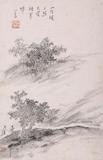花卉畫冊 冊 明陳繼儒梅花
推薦分享
資源連結
連結到原始資料 (您即將開啟新視窗離開本站)後設資料
- 資料識別:
- 故畫003513N000000005
- 資料類型:
- 類型:繪畫
- 型式:靜態圖像
- 著作者:
- 陳繼儒
- 主題與關鍵字:
- 梅(白.紅.蠟梅)
- 出版者:
- 數位化執行單位:國立故宮博物院
- 格式:
- 本幅 16.3x46.3公分、全幅 66.8x60.8公分
- 關聯:
- 故宮書畫錄(卷八),第四冊,頁163&* 陳繼儒(西元一五五八-一六三九年),江蘇華亭人,字仲醇,一字眉公,號糜公。天賦多智,少有高才,詩文書畫皆所善長,與同郡董其昌齊名。畫擅水墨梅、竹,山水亦氣韻空遠。董其昌嘗評之:「雖草草潑墨,而一種蒼老之氣,豈落吳下畫師恬俗魔境。」眉公亦自言:「若著色相尚,便與富翁俗僧無異。」「疏枝橫玉」為「明花卉畫冊」第五幅,於泥金箑面上,純假水墨揮掃枝幹蕊萼,筆筆不重形色,然益能顯現寫意花卉之雋永情趣。直可以「所作皆在筆墨畦徑之外」許之。&* Ch’en Chi-ju (style name Chung-ch’un and Mei-kung; sobriquet Mo-kung) was a native of Hua-t’ing, Kiangsu. A gifted scholar who revealed many talents early in life, Ch’en excelled at poetry, writing, calligraphy, and painting; becoming as famous as his contemporary, Tung Chi–ch’ang. Ch’en specialized in painting plum blossoms and bamboo with monochrome ink. Ch’en Chi-ju’s landscapes also had a vast atmosphere to them. Tung Ch’i-ch’ang once commented that “although he [Ch’en Chi-ju] heedlessly splashed ink to impart a kind of hoary and archaic energy [to his paintings], how can he be comsidered below the Wu [school] painters and in the realm of empty commonality?” Ch’en himself also once wrote, “If I likewise were to apply colors, [my paintings] would be no different from that of rich men and banal monks [i.e., everybody else].” “Scattered Branches of Blossoming Jade” is a painting, done on a fan speckled with gold leaf, in pure monochrome ink spread on to depict the plum trunk, branches, stamens, and calyxes. Not one of the brushstrokes gives emphasis to form or color, being able to give free rein to manifesting the intriguing atmosphere of the blossoms in “sketched ideas.” Thus, this style allows for “everything rendered to fall outside the rigld rules of brush and ink.” &* 陳繼儒,字仲醇,外號糜公(一作眉公),江蘇華亭人,生於世宗嘉靖三十七(公元一五五八)年,卒於思宗崇禎十二(公元一六三九)年。天賦多智,少有高才,諸子百家文章無不研讀,擅長做詩、作文外,又能書法繪畫。 他的繪畫態度是「無所為而畫」,繪畫主張是「重意象而不重形色」,所以,無論是山水、梅、竹、都是落筆草草,似像似非,在一片水墨糢糊濃淡中,反而能見出物形的雋永情趣來。 &* Ch’en Chi-ju (tzu Chung-shan, hao Mi-kung) came from Hua-t’ing in Kiangsu. An extremely gifted scholar, he showed his talents early in life and studied all branches of learning. Known as a poet and essayist as well as a calligrapher and painter. he belonged to the circle of Hua-t’ing scholar-painters which included Tung Chi-ch’ang and exercised a seminal influence over painting in their own time and later. Ch’en’s ideal in painting was to ignore that which is (the world of external forms) and to concentrate on expressing an idea rather than the likeness of an object. Thus, regardless of whether he painted landscape, plums, or bamboo, he wielded the brush in unrestrained freedom, spontaneously mixing thick and thin washes in a single painting. At the same time, however, he succeeded in bringing out the essential characteristics of the forms in his paintings. &*1.劉芳如,〈明陳繼儒疏枝橫玉〉,收入國立故宮博物院編輯委員會編,《畫梅名品特展》(臺北:國立故宮博物院,1991年元月初版),頁92。
- 管理權:
- 國立故宮博物院
授權聯絡窗口
- 國立故宮博物院圖像授權、出版授權、影音資料授權-申請流程說明
http://www.npm.gov.tw/zh-TW/Article.aspx?sNo=03003061






